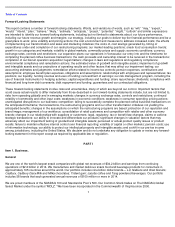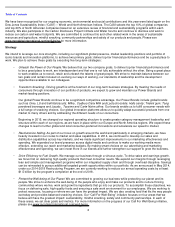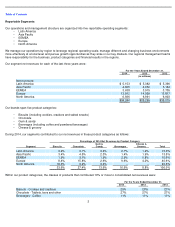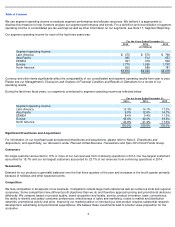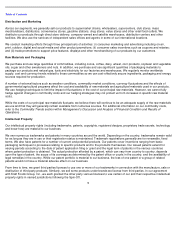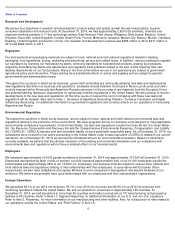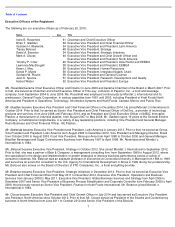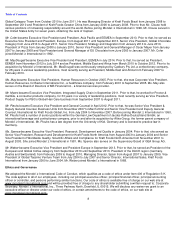Mondelez 2014 Annual Report Download - page 14
Download and view the complete annual report
Please find page 14 of the 2014 Mondelez annual report below. You can navigate through the pages in the report by either clicking on the pages listed below, or by using the keyword search tool below to find specific information within the annual report.
Table of Contents
Our operations in certain emerging markets expose us to political, economic and regulatory risks.
Our growth strategy depends in part on our ability to expand our operations in emerging markets, including Brazil, China, India,
Mexico, Russia, Venezuela, Argentina, Ukraine, the Middle East, Africa and Southeast Asia. However, some emerging markets
have greater political, economic and currency volatility and greater vulnerability to infrastructure and labor disruptions than more
established markets. In many countries outside of the United States, particularly those with emerging economies, it may be
common for others to engage in business practices prohibited by laws and regulations with extraterritorial reach, such as the FCPA
and the U.K. Bribery Act, or local anti-bribery laws. These laws generally prohibit companies and their employees, contractors or
agents from making improper payments to government officials, including in connection with obtaining permits or engaging in other
actions necessary to do business. Failure to comply with these laws could subject us to civil and criminal penalties that could
materially and adversely affect our reputation, financial condition and results of operations.
In addition, competition in emerging markets is increasing as our competitors grow their global operations and low cost local
manufacturers expand and improve their production capacities. Our success in emerging markets is critical to our growth strategy.
If we cannot successfully increase our business in emerging markets and manage associated political, economic and regulatory
risks, our product sales, financial condition and results of operations could be materially and adversely affected.
Unanticipated business disruptions could adversely affect our ability to provide our products to our customers.
We manufacture and source products and materials on a global scale. We have a complex network of suppliers, owned
manufacturing locations, co-manufacturing locations, distribution networks and information systems that support our ability to
provide our products to our customers consistently. Factors that are hard to predict or beyond our control, like weather, natural
disasters, fire, explosions, terrorism, political unrest, generalized labor unrest or health pandemics could damage or disrupt our
operations or our suppliers’ or co-manufacturers’ operations. If we do not effectively respond to disruptions in our operations, for
example, by finding alternative suppliers or replacing capacity at key manufacturing or distribution locations, or cannot quickly repair
damage to our information, production or supply systems, we may be late in delivering or unable to deliver products to our
customers. If that occurs, we may lose our customers’ confidence, and long-term consumer demand for our products could decline.
In addition, we might not have the functions, processes or organizational capability necessary to achieve on our anticipated
timeframes our strategic ambition to reconfigure our supply chain and drive efficiencies to fuel growth. Further, changes to
regulatory restrictions within the markets in which we operate may impact our ability to supply multiple markets with a streamlined
manufacturing footprint. These events could materially and adversely affect our product sales, financial condition and results of
operations.
We are subject to currency exchange rate fluctuations.
At December 31, 2014, we sold our products in approximately 165 countries and had operations in more than 80 countries. A
significant portion of our business is exposed to currency exchange rate fluctuations. Our financial results and capital ratios are
sensitive to movements in currency exchange rates because a large portion of our assets, liabilities, revenue and expenses must
be translated into U.S. dollars for reporting purposes or converted into U.S. dollars to service obligations such as our U.S. dollar-
denominated indebtedness and dividends. In addition, movements in currency exchange rates can affect transaction costs because
we source product ingredients from various countries. We seek to mitigate our exposure to exchange rate fluctuations, primarily on
cross-currency transactions, but our efforts may not be successful. Accordingly, changes in the currency exchange rates that we
use to translate our results into U.S. dollars for financial reporting purposes or for transactions involving multiple currencies could
materially and adversely affect our financial condition and results of operations.
Commodity and other input prices are volatile and may rise significantly or availability of commodities may become
constrained.
We purchase and use large quantities of commodities, including cocoa, coffee, dairy, wheat, corn products, soybean and vegetable
oils, sugar and other sweeteners, and nuts. In addition, we purchase and use significant quantities of packaging materials to
package our products and natural gas, fuels and electricity for our factories and warehouses. Prices for these raw materials, other
supplies and energy are volatile and can fluctuate due to conditions that are difficult to predict. These conditions include global
competition for resources, currency fluctuations, political conditions, severe weather, the potential longer-term consequences of
climate change on agricultural productivity, crop disease or pests, water risk, health pandemics, consumer or industrial demand,
and changes in governmental trade, alternative energy and agricultural programs. Many of the commodities we purchase are grown
by smallholder farmers, who might lack the capacity to invest to increase
11


